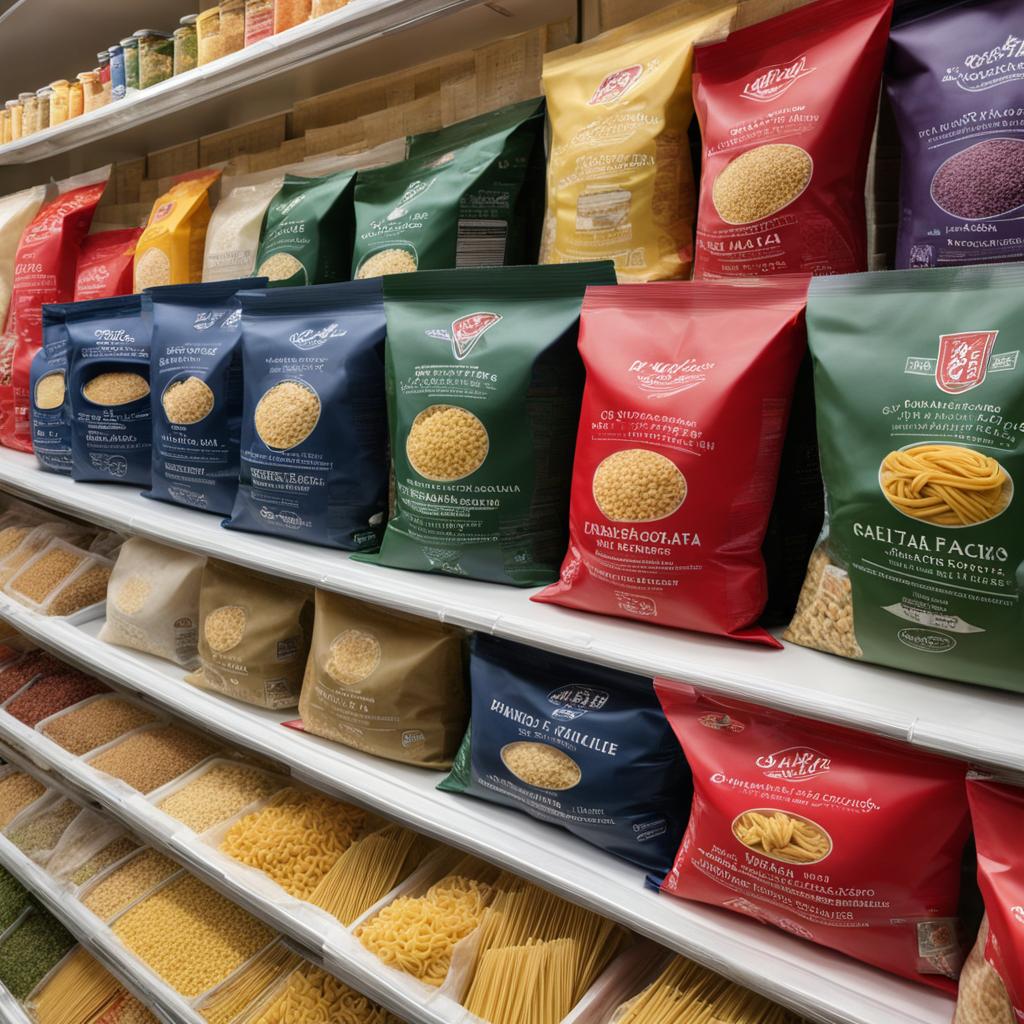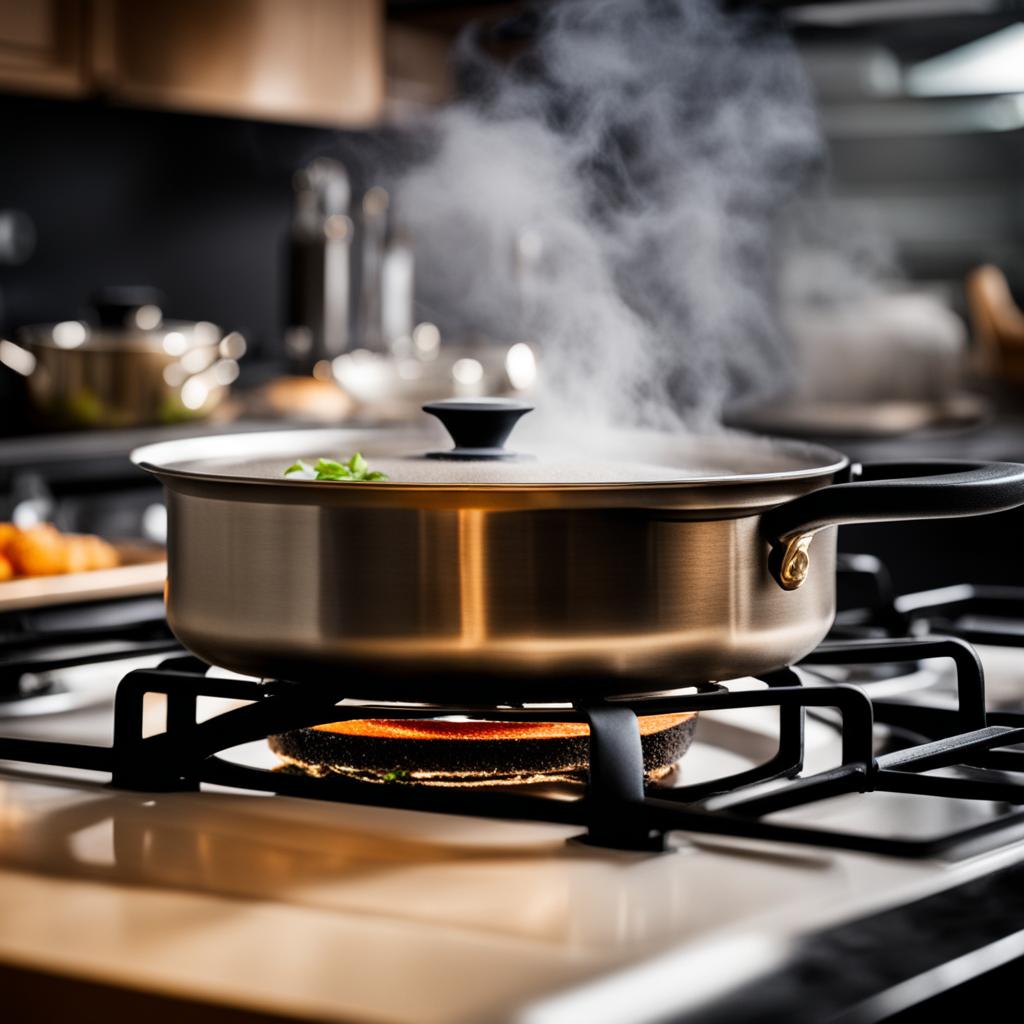Welcome to my guide on storing dry pasta for long-term use. If you’re a pasta lover like me, you know that having a reliable stash of pasta can be a game-changer in the kitchen. Whether you want to stock up for emergencies or simply want to extend the shelf life of your favorite pasta, proper storage is key. In this article, I’ll share with you the best techniques for preserving your dry pasta and ensuring its long-term freshness.
When it comes to pasta storage, it’s important to consider factors such as pasta shelf life, pasta preservation methods, and the right storage containers. By following these guidelines, you can enjoy your favorite pasta dishes whenever you want, without worrying about spoilage or loss of quality.
Key Takeaways:
- Storing pasta properly is crucial for extending its shelf life and preventing spoilage.
- Dry pasta can last indefinitely when stored in a cool, dark, and dry place.
- Choose airtight containers, such as food-grade buckets or mason jars, for storing dry pasta in smaller quantities.
- Consider using mylar bags with oxygen absorbers for long-term storage of dry pasta.
- Protect against pantry pests by keeping pasta in airtight containers and regularly inspecting for signs of infestation.
Why Proper Pasta Storage is Important
Proper pasta storage is crucial for maintaining the freshness, flavor, and quality of this versatile pantry staple. By storing pasta correctly, you can extend its shelf life and prevent spoilage, ensuring that it remains safe to eat and ready to use whenever you need it.
When pasta is stored incorrectly, it becomes susceptible to various issues. Exposure to moisture can cause the pasta to become sticky or clumpy, while exposure to air can lead to the pasta becoming stale. These unfavorable conditions can also create an environment where mold or bacteria can thrive, rendering the pasta unsafe for consumption.
To avoid these problems, it is important to follow a few simple pasta storage tips. First, make sure to store your pasta in a cool, dry place away from heat and humidity. This will help prevent moisture absorption and maintain the pasta’s texture. Second, using airtight containers such as food-grade buckets or mason jars ensures that the pasta is protected from air exposure. Finally, regularly inspect your stored pasta for any signs of pest infestation and take necessary measures to protect it from pantry pests.
Benefits of Proper Pasta Storage:
- Extended shelf life
- Maintains freshness and flavor
- Prevents spoilage and food waste
- Ensures safe consumption
By paying attention to how you store your pasta, you can enjoy its delicious taste and texture for an extended period. Whether you’re stocking up on pasta for emergencies or simply looking to preserve its quality for future use, proper storage techniques are key to getting the most out of your pasta.
| Storage Tips | Benefits |
|---|---|
| Store in a cool, dry place | Prevents moisture absorption |
| Use airtight containers | Protects from air exposure |
| Regularly inspect for pests | Prevents infestation |
Shelf Life of Dry Pasta
When it comes to dry pasta, understanding its shelf life is essential for proper storage. Dry pasta has a remarkably long shelf life, especially when stored in optimal conditions. On average, dry pasta can last 2-3 years past its “best by” date when stored in its original packaging in a cool, dark, and dry place like a pantry.
However, with proper protection against moisture, dry pasta can last even longer—up to 10 years or more. It’s important to note that different types of pasta may have varying shelf lives, so it’s wise to pay attention to specific recommendations for each type. Storing dry pasta properly not only helps to ensure its longevity but also maintains its quality for delicious meals every time.
To make it easier to understand the shelf life of different types of dry pasta, here is a table summarizing the average shelf life:
| Type of Pasta | Average Shelf Life |
|---|---|
| Spaghetti | 2-3 years past “best by” date |
| Penne | 2-3 years past “best by” date |
| Macaroni | 2-3 years past “best by” date |
| Shells | 2-3 years past “best by” date |
| Lasagna | 2-3 years past “best by” date |
| Farfalle (Bowtie) | 2-3 years past “best by” date |
As you can see, most types of dry pasta have a similar shelf life. By storing them properly and paying attention to the recommended guidelines, you can enjoy your favorite pasta dishes for years to come.
Best Storage Containers for Dry Pasta
When it comes to storing dry pasta for long-term use, choosing the right storage containers is crucial. The right containers will help maintain the quality and freshness of your pasta, ensuring that it stays safe to eat for an extended period. Here are some of the best storage containers for dry pasta:
Airtight Containers
Airtight containers are perfect for storing dry pasta in smaller quantities. These containers create a seal that prevents moisture and air from reaching the pasta, keeping it fresh and preserving its shelf life. Look for containers made from food-grade materials to ensure their safety for storing food items. Popular options include plastic or glass containers with secure lids that provide a tight seal.
Food-Grade Buckets
For bulk storage of dry pasta, food-grade buckets are an excellent choice. These buckets are designed to hold large quantities of food and are typically made from materials that comply with food safety regulations. Make sure the bucket has a tight-fitting lid to keep out moisture and contaminants. Labeling the buckets with the type and date of pasta stored inside can help with organization and rotation.
Mason Jars
Mason jars are not only charming but also practical for storing dry pasta. They come in various sizes and are made of glass, which is a non-porous material that won’t absorb odors or flavors. Mason jars provide an airtight seal when properly closed, keeping the pasta fresh and protected from moisture. They are ideal for smaller quantities of pasta and can be an attractive addition to your pantry shelves.
Remember to clean and dry the containers thoroughly before transferring the pasta to them, ensuring that no residual moisture is present. Additionally, store your pasta containers in a cool, dry place away from direct sunlight to maintain the quality and longevity of your stored pasta. By using the right storage containers, you can confidently store your dry pasta and have it readily available whenever you need it.
How to Pack Dry Pasta for Long-term Storage
Properly packing dry pasta is crucial for maintaining its quality and extending its shelf life during long-term storage. By transferring your dry pasta from its original packaging to suitable storage containers or bags, you can create airtight environments that protect against moisture and prevent spoilage.
When it comes to packing dry pasta for long-term storage, two commonly used options are pasta storage bags and mylar bags. Pasta storage bags are designed specifically for keeping pasta fresh and often come with zipper seals for easy access. Mylar bags, on the other hand, provide an extra layer of protection with their durable and airtight properties.
“Properly packed dry pasta can last for many years.”
To further enhance the preservation of your dry pasta, consider using oxygen absorbers in conjunction with your chosen storage bags. Oxygen absorbers remove the oxygen that can contribute to the growth of bacteria and mold, helping to maintain the pasta’s freshness for an extended period.
| Packaging Option | Advantages | Disadvantages |
|---|---|---|
| Pasta Storage Bags | – Designed specifically for pasta storage – Easy access with zipper seals |
– May not provide as much protection against moisture as mylar bags |
| Mylar Bags | – Durable and airtight – Provides excellent protection against moisture |
– May require additional tools for sealing, such as heat sealers |
Remember to label your storage bags or containers with the date of packing to ensure you are rotating your pasta supply properly. Additionally, store your packed dry pasta in a cool and dark place, away from heat sources, to further safeguard its quality.

Summary:
- Pack dry pasta for long-term storage in suitable storage bags or containers.
- Consider using pasta storage bags or mylar bags, which provide airtight environments for preserving pasta freshness.
- Enhance preservation by using oxygen absorbers to remove oxygen.
- Label storage bags or containers with packing date and store in a cool, dark place.
Protecting Against Pests
When it comes to pasta storage, one of the main challenges is protecting it against pantry pests. These pests, such as weevils and moths, can infest your stored pasta and render it inedible. To ensure the quality and safety of your pasta, it is essential to take measures to prevent and control these pests.
One of the best ways to protect your pasta from pantry pests is by storing it in airtight containers or mylar bags. These containers create a barrier that keeps pests out, preventing them from accessing your pasta. It is also recommended to store these containers inside food-grade buckets, which provide an additional layer of protection.
In addition to proper storage containers, it is important to keep your pasta storage area clean and free of any spilled grains or food debris. Regularly check for signs of pest infestation, such as the presence of small larvae or moths in or around your pasta storage area. If you notice any signs of infestation, take immediate action to eliminate the pests and dispose of any affected pasta.
Common Pantry Pests
| Pest | Description | Prevention |
|---|---|---|
| Indianmeal Moth | A common pest that infests stored grains, including pasta. The adult moths are about 1/2-inch long and have distinctive reddish-brown wings. | – Use airtight containers – Clean storage area regularly – Inspect pasta for signs of infestation |
| Granary Weevil | A small beetle that infests stored grains, including pasta. The adult weevils are about 1/8-inch long and reddish-brown in color. | – Store pasta in airtight containers – Keep storage area clean and dry – Freeze pasta before storing to kill any eggs or larvae |
| Drugstore Beetle | A small beetle that infests stored food products, including pasta. The adult beetles are about 1/10-inch long and reddish-brown in color. | – Store pasta in airtight containers – Inspect pasta for signs of infestation – Dispose of infested pasta and clean storage area |
Keeping your pasta safe from pantry pests requires diligence and proper storage techniques. By storing your pasta in airtight containers, regularly inspecting for signs of infestation, and maintaining a clean storage area, you can protect your pasta and ensure its quality for long-term storage.

Freezing Fresh Pasta
When it comes to preserving the freshness of fresh pasta for an extended period, freezing is a great option. Freezing fresh pasta allows you to enjoy its delicious taste and texture even after a while. The process is simple and straightforward, ensuring that your pasta remains in top-quality condition for future use.
To freeze fresh pasta, start by tightly wrapping it in plastic wrap. This helps to prevent freezer burn and maintain the pasta’s moisture. After wrapping, place the wrapped pasta in a freezer-safe plastic bag or container to provide an additional layer of protection. It’s important to label the bag or container with the date of freezing to keep track of its freshness.
When it comes time to thaw the frozen pasta, the best method is to transfer it from the freezer to the refrigerator. Allow the pasta to thaw slowly in the fridge overnight. This gradual thawing process ensures that the pasta retains its original texture and flavor. Once thawed, you can cook the pasta as you normally would, and it will be just as delicious as freshly made.
By freezing fresh pasta, you can conveniently have it on hand whenever you need it. Whether it’s for a quick weeknight meal or a special occasion, having frozen fresh pasta in your freezer ensures that you’re always prepared to create a delicious and satisfying dish.
Reheating Cooked Pasta
When it comes to reheating cooked pasta, there are a few methods you can use to bring back that delicious taste and texture. The key is to reheat the pasta without drying it out or making it mushy. Here are some pasta reheating methods that you can try:
1. Boiling Water Method:
The boiling water method is a quick and easy way to heat up your cooked pasta. Simply place the pasta in a metal strainer and dip it into a pot of boiling water for about 30 seconds or until it is warmed through. This method helps to revive the pasta and restore its al dente texture.
2. Microwave Method:
If you’re looking for a faster option, the microwave method is a great choice. Place your cooked pasta in a microwave-safe bowl and cover it with a damp paper towel. Microwave the pasta on high for about 1 minute, stirring halfway through. Check the pasta for doneness and continue microwaving in 30-second intervals if needed.
3. Stovetop Method:
The stovetop method is another effective way to reheat cooked pasta. Start by heating a small amount of olive oil or butter in a skillet over medium heat. Add the pasta to the skillet and toss it gently to coat with the oil or butter. Cook the pasta for a few minutes, stirring occasionally, until it is heated through.
Remember to store your cooked pasta and sauce separately in airtight containers in the fridge before reheating. This helps to maintain the pasta’s texture and prevents it from absorbing too much moisture from the sauce. By using these reheating methods, you can enjoy a fresh and delicious plate of pasta, even when you’re not cooking it from scratch.

Using Store-Bought Pesto
If you’re looking to add a burst of flavor to your dishes, store-bought pesto is a convenient and versatile option. Not just limited to pasta, store-bought pesto can be used to enhance the taste of various recipes, giving them a vibrant and aromatic twist. Here are some creative ways to incorporate store-bought pesto into your cooking repertoire:
- Pesto Pasta: Of course, the classic way to use pesto is as a sauce for pasta. Toss cooked pasta with store-bought pesto to coat the noodles completely. Add some freshly grated Parmesan cheese and a drizzle of olive oil for a simple yet satisfying meal.
- Pesto Chicken: Spread a generous amount of pesto on boneless, skinless chicken breasts before baking or grilling. The pesto infuses the chicken with a burst of flavor and keeps it moist and tender.
- Pesto Pizza: Instead of the usual tomato sauce, spread a layer of pesto on your pizza base. Top it with your favorite ingredients like mozzarella, cherry tomatoes, and fresh basil for a delicious and unique twist.
- Pesto Salad Dressing: Mix store-bought pesto with a little olive oil, lemon juice, and a pinch of salt to create a zesty salad dressing. Drizzle it over your favorite greens or use it as a marinade for grilled vegetables.
These are just a few ideas to get you started, but the possibilities with store-bought pesto are virtually endless. Let your creativity take the lead and experiment with different recipes to find your favorite ways to incorporate this flavorful ingredient into your meals.
“Store-bought pesto adds a burst of fresh flavor to any dish, whether it’s pasta, chicken, pizza, or salad. Its versatility makes it a pantry staple that can elevate your cooking in no time.”
Store-Bought Pesto Recipes
To help you get started, here are a couple of recipes that showcase the versatility of store-bought pesto:
| Recipe | Ingredients | Instructions |
|---|---|---|
| Pesto Caprese Skewers | Fresh mozzarella balls, cherry tomatoes, basil leaves, store-bought pesto, balsamic glaze | Thread a mozzarella ball, cherry tomato, and basil leaf onto a skewer. Drizzle with pesto and balsamic glaze. Serve as an appetizer or snack. |
| Pesto Grilled Cheese Sandwich | Sourdough bread, mozzarella cheese, store-bought pesto | Spread pesto on one side of each bread slice. Place mozzarella cheese between the bread slices, with the pesto side facing the cheese. Grill the sandwich until the cheese is melted and the bread is golden brown. Enjoy! |
These recipes are just a starting point. Feel free to modify them to suit your taste preferences and get creative with your own pesto-inspired creations. Store-bought pesto is a convenient and delicious way to add a burst of flavor to your dishes, making mealtime more exciting and enjoyable.
Pasta Storage Methods: Vacuum Sealing and More
When it comes to long-term pasta storage, there are various methods you can use to ensure the freshness and quality of your pasta. One popular technique is vacuum sealing, which involves removing all the air from the storage bags or containers to create an airtight environment. Vacuum sealing not only extends the shelf life of your pasta but also helps to preserve its flavors and textures.
Another effective storage method is using mylar bags. These sturdy, food-grade bags provide an additional layer of protection against moisture, pests, and other external factors that can lead to pasta spoilage. To maximize the effectiveness of mylar bags, consider using oxygen absorbers along with them. Oxygen absorbers help to create an oxygen-free environment, further preventing the growth of mold or bacteria.
If you prefer a more accessible and budget-friendly option, ziplock bags can also be used for pasta storage. Just make sure to remove as much air as possible from the bag before sealing it. While ziplock bags may not provide the same level of protection as vacuum sealing or mylar bags, they can still help to extend the shelf life of your pasta if stored in a cool, dry place.
Comparison of Pasta Storage Methods
| Storage Method | Benefits | Limitations |
|---|---|---|
| Vacuum Sealing | – Extends shelf life – Preserves flavors and textures |
– Requires a vacuum sealer – Can be more expensive |
| Mylar Bags with Oxygen Absorbers | – Provides extra protection – Creates an oxygen-free environment |
– Requires oxygen absorbers – May be less accessible |
| Ziplock Bags | – Budget-friendly option – Suitable for short-term storage |
– Less effective at preventing spoilage – Limited protection against moisture and pests |
Ultimately, the choice of pasta storage method depends on your personal preferences, resources, and the length of time you plan to store your pasta. Each method offers its own advantages and limitations, so it’s important to consider your specific needs and circumstances when deciding how to best store your pasta.
Final Thoughts on Pasta Storage
Proper pasta storage is crucial for preserving its taste and quality in the long term. Whether you’re stocking up for emergencies or looking to extend the shelf life of your pasta, following these tips will ensure that your supply remains fresh and ready to use when you need it most.
Storage Tips
- Choose the right containers: Opt for airtight containers like food-grade buckets or mason jars to keep moisture and pests out. These containers provide an added layer of protection for your pasta.
- Pack it properly: Transfer your dry pasta from its original packaging to airtight storage bags or containers. Consider using mylar bags with oxygen absorbers for the ultimate pasta preservation.
- Keep it cool and dry: Store your pasta in a cool, dark place away from heat sources. Moisture and heat can lead to spoilage, so it’s important to create a dry environment for optimal storage.
- Inspect and rotate: Regularly check your stored pasta for signs of pests or spoilage. Rotate stock by using older pasta first and replenishing with new supplies.
By implementing these pasta storage tips, you can confidently build an emergency food supply or enjoy long-term pasta storage. Remember to take precautions against pantry pests and maintain the proper storage conditions to ensure the best quality for your pasta. With these practices in place, you’ll always have a reliable source of nourishment at your fingertips.
Image:
| Storage Tip | Description |
|---|---|
| Choose the right containers | Use airtight containers like food-grade buckets or mason jars to prevent moisture and pests from reaching your pasta. |
| Pack it properly | Transfer dry pasta to airtight storage bags or containers, and consider using mylar bags with oxygen absorbers for extended preservation. |
| Keep it cool and dry | Store pasta in a cool, dark place away from heat sources to prevent spoilage. Heat and moisture can degrade the quality of your pasta. |
| Inspect and rotate | Regularly check stored pasta for signs of pests or spoilage, and rotate stock by using older pasta first and replenishing with fresh supplies. |
Conclusion
In conclusion, proper pasta storage is crucial for long-term use and to maintain the quality and freshness of your dry pasta. By following the storage guidelines and tips provided in this article, you can confidently store your pasta for extended periods, ensuring that it remains safe to eat and ready to use whenever you need it.
Remember to choose the right storage containers, such as airtight food-grade buckets or mason jars, to protect your pasta from moisture and air. Utilizing mylar bags with oxygen absorbers can also create an oxygen-free environment that helps preserve the pasta’s freshness for many years.
Additionally, protecting against pests is essential. Store your pasta in airtight containers or mylar bags inside food-grade buckets and keep them off the floor. Regularly inspecting for signs of pest infestation will help maintain the quality and safety of your stored pasta.
By creating an ideal storage environment, storing pasta away from heat sources, and following proper reheating methods, you can enjoy your pasta for an extended period. Whether you’re preparing for emergencies or building a long-term food supply, these storage techniques will ensure that your pasta remains a reliable and delicious staple in your pantry.
FAQ
How long can dry pasta be stored?
Dry pasta can be stored for 2-3 years past its “best by” date when stored in a cool, dark, and dry place like a pantry. With proper protection against moisture, dry pasta can last over 10 years.
What are the best storage containers for dry pasta?
Airtight containers, such as food-grade buckets or mason jars, are ideal for storing dry pasta in smaller quantities. These containers prevent moisture and air from reaching the pasta, keeping it fresh for longer periods.
How should dry pasta be packed for long-term storage?
It is recommended to remove dry pasta from its original packaging and transfer it to airtight containers or storage bags. Mylar bags, combined with oxygen absorbers, create an oxygen-free environment that helps preserve the pasta’s freshness and prevent spoilage.
How can I protect stored pasta from pests?
To protect against pests, store pasta in airtight containers or mylar bags inside food-grade buckets. Keeping the containers off the floor and regularly inspecting for signs of pest infestation can help maintain the quality and safety of stored pasta.
What are the best storage conditions for pasta?
The ideal storage conditions for dry pasta include a cool, dry, and dark place. Storing pasta away from heat sources, such as water heaters or washing machines, ensures better preservation of its quality and taste.
Can fresh pasta be frozen for long-term storage?
Yes, fresh pasta can be frozen for up to a month. Tightly wrap it in plastic wrap and place it in a freezer-safe plastic bag. Thaw frozen pasta in the refrigerator overnight before using it.
How should I reheat cooked pasta?
To reheat cooked pasta, store the pasta and sauce separately in airtight containers in the fridge. When ready to reheat, place the pasta in a metal strainer and dip it in boiling water for about 30 seconds or until warmed through. Heat the sauce separately before adding it to the pasta.
What are some other uses for store-bought pesto?
Store-bought pesto can be used in various dishes beyond pasta. It can be added to dressings, marinades, or used as a flavorful topping for meats and vegetables.
What are some additional pasta storage methods?
Vacuum sealing, using mylar bags with oxygen absorbers, or ziplock bags can provide additional protection for long-term pasta storage. These methods help create a more airtight environment and preserve the quality and freshness of the pasta.
Why is proper pasta storage important?
Proper pasta storage is crucial to maintain freshness, prevent spoilage, and ensure a reliable food supply. By following the recommended storage guidelines, you can extend the shelf life of your pasta and be prepared for emergencies or long-term food storage needs.
What should I keep in mind when storing dry pasta?
Regularly inspect and rotate your stored pasta to maintain its quality. Follow the recommended storage tips and techniques to ensure the longevity of your dry pasta.
Source Links
- https://www.realsimple.com/how-to-store-pasta-6931366
- https://valleyfoodstorage.com/blogs/inside-vfs/long-term-storage-pasta-how-to
- https://www.primalsurvivor.net/store-pasta-long-term/
Related Recipes:
 How to Reheat Pasta Without Losing Flavor
How to Reheat Pasta Without Losing Flavor
 How to Store Fish to Ensure Freshness
How to Store Fish to Ensure Freshness
 How to Store Parsley? (Perfect Every Time!)
How to Store Parsley? (Perfect Every Time!)
 Does Almond Milk Go Bad? How to Tell and Storage Tips.
Does Almond Milk Go Bad? How to Tell and Storage Tips.
 Does Peanut Butter Go Bad? Shelf Life and Storage Tips
Does Peanut Butter Go Bad? Shelf Life and Storage Tips
 Beef Stew Shelf Life: How Long Does It Last in the Fridge?
Beef Stew Shelf Life: How Long Does It Last in the Fridge?
 How to Store Carrots? (Perfect Every Time!)
How to Store Carrots? (Perfect Every Time!)
 How to Store Baked Goods to Keep Them Fresh
How to Store Baked Goods to Keep Them Fresh







